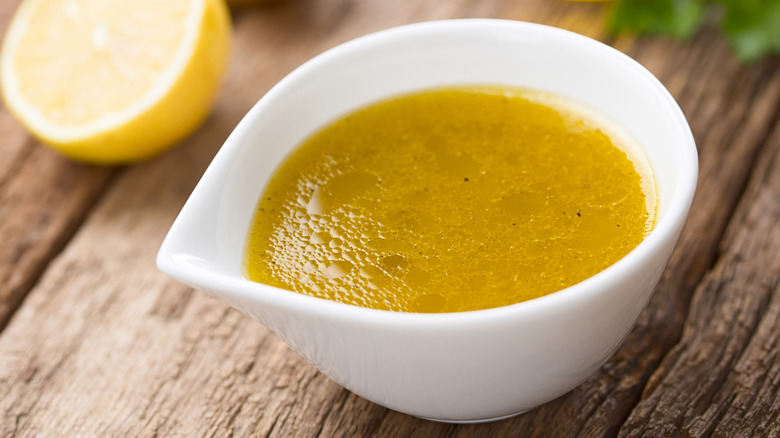The Temperature Trick That Totally Changes Salad Dressing
Many folks opt to make homemade vinaigrette because it's easy, cheap, and often better than what you can get at a store. While finding ways to improve it without a lot of cost or time may be a challenge, Eve Cartwright, co-founder and EVP of Nan's Original Recipes, told Food Republic that warming it is a great way to elevate its flavor without much effort.
"Warm food releases more volatile compounds, which are essential for smell, a large component of taste," Cartwright explained. "Warm vinaigrettes coat your taste buds, acting as a good transport system for sweet and salty flavors." Heat not only mellows harsh flavors like raw garlic but also affects the flavor release of spices. By bringing flavorful oils to the surface, your spices have an easier time flavoring your acids and oils of choice, meaning you'll have to use less of them for the same result. This is particularly helpful when using old spices, as they tend to lose some of their potency over time.
According to Cartwright, all you need to do is "shake or whisk it vigorously before adding to the pan and then stir constantly on low heat." While most recipes are foolproof, heat does create some risk of ruining delicate ingredients like sugar, extra virgin olive oil, or fine vinegars. Provided you treat your recipe gently, you should end up with an improved vehicle for flavor in everything from roasted vegetables to salads.
Common mistakes to avoid with warmed vinaigrettes
One of the biggest mistakes people make when preparing vinaigrettes is at the emulsion step. You'll need the right ratio of oil and vinegar, constant whisking, and an emulsifier like Dijon mustard to mix everything into a silky smooth sauce. Combining all these with gentle heat can help you achieve the best possible flavor and texture.
"Warm vinaigrettes generally pair best with salads made from sturdy greens and ingredients that can soften slightly from the heat without fully wilting, which provides a contrast in textures," Eve Cartwright explained. Picking the right type of lettuce can be tricky because many that don't wilt from a tiny amount of heat can also be quite bitter. Romaine, endive, and other high-water, firm-leaved greens are great choices. If you opt for something like kale or chard, you might want to add a bit of sugar to balance out their flavors.
"Storing a vinaigrette with olive oil in the refrigerator will cause the oil to solidify and separate and become thick and unpourable," Cartwright added. However, this is easily fixed with heat and a whisk, bringing it back to the same texture it had when fresh. Homemade vinaigrette stays good for two weeks in the fridge, but dairy ingredients and repeated heating and cooling can introduce more bacteria. Be sure to only heat up as much as you think you'll use for each portion to avoid making your dressing go bad.


